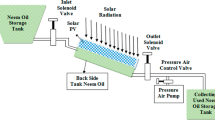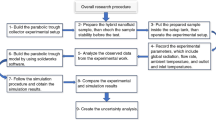Abstract
This study presents a novel solar concentrating photovoltaic/concentrating solar power (CPV/CSP) hybrid system, which mainly contains CPV modules with an evaporative cooling subsystem, a thermal receiver and an organic Rankine cycle (ORC). The cooling fluid is boiled when cooling the CPV modules, and superheated vapor that is effective for power generation with an ORC is generated after absorbing low-concentration solar radiation in the thermal receiver. A steady-state physical model is developed to carry out energy analysis of the hybrid system. The results show that when saturated vapor is fed into the thermal receiver, the peripheral low-concentration solar radiation that is discarded in conventional CPV or CPV/thermal systems is effective to get a high-temperature superheated vapor (e.g., above 120 °C). The overall solar-to-electricity efficiency can be increased from 28.4 % for the conventional CPV system to 44 % for the hybrid system with 500 suns. Even though the overall efficiency decreases from 44.0 % to 36.8 % when the concentration ratio increases from 500 to 2,000 suns, there is still a considerable efficiency improvement compared with the conventional CPV systems. The results indicate that the proposed hybrid system provides a viable solution for solar power generation with high efficiencies.
摘要
为了提高聚光光伏系统的能量利用效率, 本文提出了一种新型的聚光光伏/光热混合发电系统, 该系统主要由带有蒸发冷却装置的聚光光伏模块、光热接收器和有机朗肯循环组成. 液体有机工质在冷却聚光光伏模块时吸热蒸发, 而后流经外围低聚光光热接收器时加热成为过热蒸汽, 最终经由有机朗肯循环发电. 针对该混合发电系统, 本文提出了稳态模型, 并进行了系统能量分析. 结果表明利用聚光光伏模块外围的低聚光能量可以有效产生较高温度 (例如, 大于 120 °C) 的过热蒸汽. 当聚光比为500倍时, 该系统可以将整体光电转换效率从传统的聚光光伏电池的28.4 %显著提高到44 %. 因此, 该混合发电系统为太阳能的更高效率发电提供了新的发展方向.







Similar content being viewed by others
Abbreviations
- A :
-
Area (m2)
- d :
-
Diameter (m)
- err :
-
Error
- \( \varvec{h} \) :
-
Enthalpy (\( {\text{kJ}}/({\text{kg K}}) \)) or convective heat transfer coefficient (\( {\text{W}}/({\text{m}}^{2} \;{\text{K}}) \))
- \( \varvec{I} \) :
-
Current (A)
- \( \varvec{k}_{{\mathbf{B}}} \) :
-
Boltzmann’s constant \( ( {\text{m}}^{2} \;{\text{kg}}/({\text{s}}^{2} \;{\text{K}}) ) \)
- \( \varvec{n} \) :
-
Diode ideality factor
- \( \varvec{Nu} \) :
-
Nusselt number
- \( \varvec{N}/\varvec{ X} \) :
-
Concentration ratio
- \( \varvec{P} \) :
-
Electricity energy (W)
- \( \varvec{Pr} \) :
-
Prandtl number
- \( \varvec{Q} \) :
-
Energy (W)
- \( \varvec{q} \) :
-
Elementary charge (C) or heat flux (W/m2)
- \( \varvec{q}_{\varvec{m}} \) :
-
Mass flow (kg/s)
- \( \varvec{R} \) :
-
Series resistance (Ω) or heat resistance (\( {\text{K m}}^{2} /{\text{W}} \))
- \( \varvec{r} \) :
-
Radius (m)
- \( \varvec{Re} \) :
-
Reynolds number
- \( \varvec{T} \) :
-
Temperature (°C)
- \( \varvec{V} \) :
-
Voltaic (V)
- \( \varvec{v}\text{/}\varvec{u} \) :
-
Velocity (m/s)
- \( \varvec{v}_{\varvec{f}} \) :
-
Kinematic viscosity (m2/s)
- \( \varvec{W} \) :
-
Output power (W)
- x :
-
Quality
- η :
-
Efficiency
- ε :
-
Emissivity
- σ :
-
Standard deviation or Stefan–Boltzmann constant
- β :
-
Temperature coefficient
- ρ :
-
Reflectivity or density (kg/m3)
- λ :
-
Thermal conductivity (W/(m K))
- ab:
-
Absorbed
- air:
-
Air
- ave:
-
Average
- c:
-
Concentration ratio
- conv:
-
Convective heat loss
- CPV:
-
DA-CPV (dense-array concentrated photovoltaic)
- CSP:
-
Concentrating solar power
- em:
-
Emissive heat loss
- g:
-
Gas
- I:
-
Current
- in:
-
Incident or inlet
- l:
-
Liquid
- loss:
-
Heat loss
- m:
-
Mass
- max:
-
Maximum
- n:
-
Natural convection
- oc:
-
Open circuit
- out:
-
Output or outlet
- p:
-
Pipes
- R:
-
R134a
- r:
-
Reference point
- ref:
-
Reflective heat loss
- s:
-
Surface
- sc:
-
Short circuit
- sky:
-
Sky
- so:
-
Solar cells
- V:
-
Voltage
- w:
-
Wall surface
References
Mbewe DJ, Card HC, Card DC (1985) A model of silicon solar cells for concentrator photovoltaic and photovoltaic/thermal system design. Sol Energy 35:247–258
Zhu L, Wang YP, Fang ZL et al (2010) An effective heat dissipation method for densely packed solar cells under high concentrations. Sol Energy Mater Sol Cells 94:133–140
Huang MJ, Eames PC, Norton B (2004) Thermal regulations of building-integrated photovoltaics using phase change materials. Int J Heat Mass Transf 47:2715–2733
Zondag HA, de Vries DW, van Helden WGJ et al (2002) The thermal and electrical yield of a PV thermal collector. Sol Energy 72:113–128
Ibrahim A, Othman MY, Ruslan MH et al (2011) Recent advances in flat plate photovoltaic/thermal solar collectors. Renew Sustain Energy Rev 15:352–365
Kribus A, Kaftori D, Mittelman G et al (2006) A miniature concentrating photovoltaic and thermal system. Energy Convers Manag 47:3582–3590
Mittelman G, Kribus A, Dayan A (2007) Solar cooling with concentrating photovoltaic/thermal (CPVT) systems. Energy Convers Manag 48:2481–2490
Ji J, Li J, Pei G (2011) Solar-energy low-temperature thermal power-generation and photovoltaic power-generation combination system. PRC patent, CN101608606A, 2011.10.19
Xu XQ, Meyers MM, Sammakia BG et al (2013) Thermal modeling and life prediction of water-cooled hybrid concentrating photovoltaic/thermal collectors. J Sol Energy Eng 135:011010
Mojiri A, Taylor R, Thomsen E et al (2013) Spectral beam splitting for efficient conversion of solar energy—a review. Renew Sustain Energy Rev 28:654–663
Jiang SL, Hu P, Mo SP et al (2010) Optical modeling for a two-stage parabolic trough concentrating photovoltaic/thermal system using spectral beam splitting technology. Sol Energy Mater Sol Cells 94:1686–1696
Shou CH, Luo ZY, Wang T et al (2011) A dielectric multilayer filter for combining photovoltaics with a Stirling engine for improvement of the efficiency of solar electricity generation. Chin Phys Lett 28:8402
Ousterhout JN, Olson D (2013) Power generation using simultaneous capture of solar photovoltaic and solar thermal energy. JTMAE 29:1–12
Green MA (2006) Third generation photovoltaics. Advanced solar energy conversion. Springer, New York
Ju X, Vossier A, Wang Z et al (2013) An improved temperature estimation method for solar cells operating at high concentration. Sol Energy 93:80–89
Royne A, Dey CJ, Mills DR (2005) Cooling of photovoltaic cells under concentrated illumination: a critical review. Sol Energy Mater Sol Cells 86:451–483
Nasby RD, Sanderson RW (1982) Performance measurement techniques for concentrator photovoltaic cells. Sol Cells 6:39–47
Li X, Kong WQ, Wang ZF et al (2010) Thermal model and thermodynamic performance of molten salt cavity receiver. Renew Energy 35:981–988
Swinbank WC (1963) Long-wave radiation from clear skies. Q J R Meteorol Soc 89:339–348
McAdams WH (1958) Heat transmission, 3rd edn. McGraw-Hill, New York
Acknowledgments
This work was supported by the National Natural Science Foundation of China (51106149 and 51406051), the Fundamental Research Funds for the Central Universities and the Foundation of Key Laboratory of Thermo-Fluid Science and Engineering (Xi’an Jiaotong University), Ministry of Education, Xi’an 710049, China.
Conflict of interest
The authors declare that they have no conflict of interest.
Author information
Authors and Affiliations
Corresponding authors
About this article
Cite this article
Han, X., Xu, C., Ju, X. et al. Energy analysis of a hybrid solar concentrating photovoltaic/concentrating solar power (CPV/CSP) system. Sci. Bull. 60, 460–469 (2015). https://doi.org/10.1007/s11434-015-0738-7
Received:
Accepted:
Published:
Issue Date:
DOI: https://doi.org/10.1007/s11434-015-0738-7




